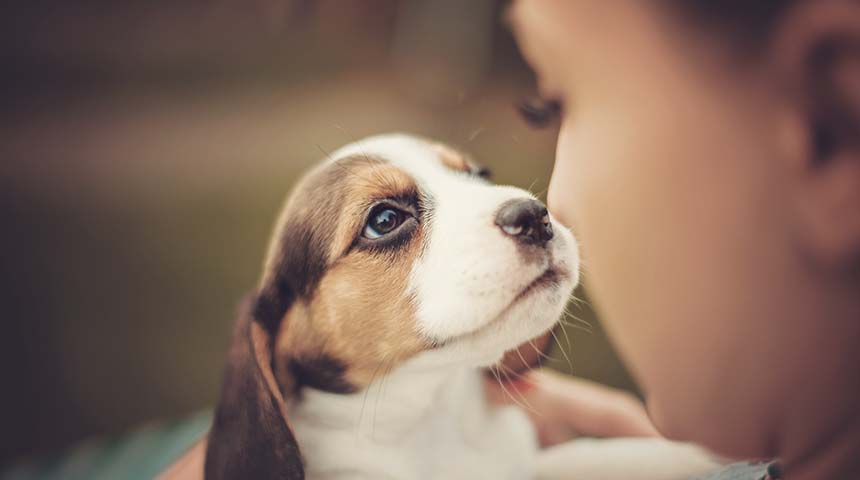
Congratulations for your new companion! The arrival of this little "furball" comes with many responsibilities that you'll need to take care of all of its life, and especially during its first year. Below is information that could be especially useful. During your visit, the veterinarian will be happy to answer all your questions.
Vaccination
During your first visit, the veterinarian will determine with you which diseases your animal could be exposed to, and the appropriate vaccination schedule.
For puppies, it is important that they receive the basic vaccines that give protection against infectious diseases such as distemper, coronavirus, parvovirus, and rabies.
Vaccination can begin as early as the age of 6 weeks, with a booster shot every 3 or 4 weeks until the animal reaches the age of 12 to 16 weeks.
Then, an annual exam is recommended and at that time, the veterinarian will discuss with you which vaccines your pet should receive during the year.
Don't forget to tell the veterinarian if you will be using boarding or grooming services, or training classes. The vaccine against kennel cough (bordetella) will then be necessary.
Deworming
At your first visit, a stool analysis (coprology) is recommended to identify the different intestinal parasites that your pet may have, to allow us to prescribe an appropriate treatment. Since your pet can be contaminated when it goes outside, a yearly analysis is ideal.
Routine Surgery
Sterilization (castration for males and ovariohysterectomy for females) will be done when your pet is around 6 months. To reduce the risk of complications, it is preferable that your pet not be in heat at the time of surgery.
If your veterinarian recommends an umbilical hernia correction or the extraction of baby teeth for your female dog, this can be done at the same time as sterilization.
We recommend preoperative blood tests to make sure that your animal can safely undergo anesthesia and to help in the selection of the appropriate anesthetic agent; this reduces anesthetic risks. All animals that have had elective (routine) surgery receive post-operative analgesics, so they will be more comfortable when they wake up and go home. Antibiotics can also be prescribed to reduce the risk of infections.
Nutrition
Up to 6 to 12 months of age, a puppy should be fed (depending on its weight and race) with food that will foster good growth.
It is recommended that puppies be fed 2 to 3 times a day; leave the dog's bowl out for 15 to 20 minutes. After that, remove the bowl even if there is some food left. To housebreak your dog more easily, don't leave food around. If you know when your dog eats, you will have better control over the timing of its natural needs (urine and stools).
When you change to adult dog food, make sure the transition is gradual; don't make an abrupt change as this could cause diarrhea and/or vomiting. If you have several dogs, make sure each one eats its portion; ideally, each pet should have its own bowl. As they get older, our pets are subject to obesity problems; to help avoid these problems, don't let them self-feed.
Heartworms
In Québec, dogs can receive heartworm protection from June to November; products are readily available and easy to administer.
If you travel abroad with your dog, plan for a longer protection according to the length of your stay. There are many products available, in different forms: topical, injectable or in tablets; talk to your veterinarian. Some products even have a combined action preventing fleas, worms, mites, ticks, etc. A screening test (blood test) must be done before prescribing the medication. This detection test is not necessary for puppies born after the month of August of the current year; these dogs have probably never come into contact with mosquitoes, which are the vector of transmission.
Fleas
Do you know that there is a simple test that you can do at home to make sure that your cat is not infested with fleas? Ask a technician for a demonstration. Several products are available for control and/or treatment. Each product works in a different way; let us help you choose the right product for your needs.
Ear Cleaning
As with humans, dogs can have ear infections; but with regular ear cleaning, you will be able to avoid this problem. Use an appropriate product and the proper technique; the veterinarian or the technician will show you how to proceed.
Nail Clipping
The golden rule: Don't cut too short and clip more often. Stroke the legs of your kitten or puppy often so that it gets used to being handled; this way, it will be less nervous when its nails are clipped. Clip your pet's nails when it is calm.
Dental hygiene
As with people, your pet’s teeth should be brushed often. Of course, a specially formulated pet toothpaste should be used; one that does not contain fluoride. In addition, some food companies offer kibble especially made to reduce plaque and tartar build-up because of their abrasive action during mastication; please note that they do not replace brushing. Our technicians and veterinarians will be happy to give you advice on the best food, don’t hesitate to ask for advice.
Human Pharmacy
Get the right information before giving medication from your pharmacy to your pet; human medications are often toxic for them. Call your veterinarian before playing doctor! You risk worsening your animal's condition.

